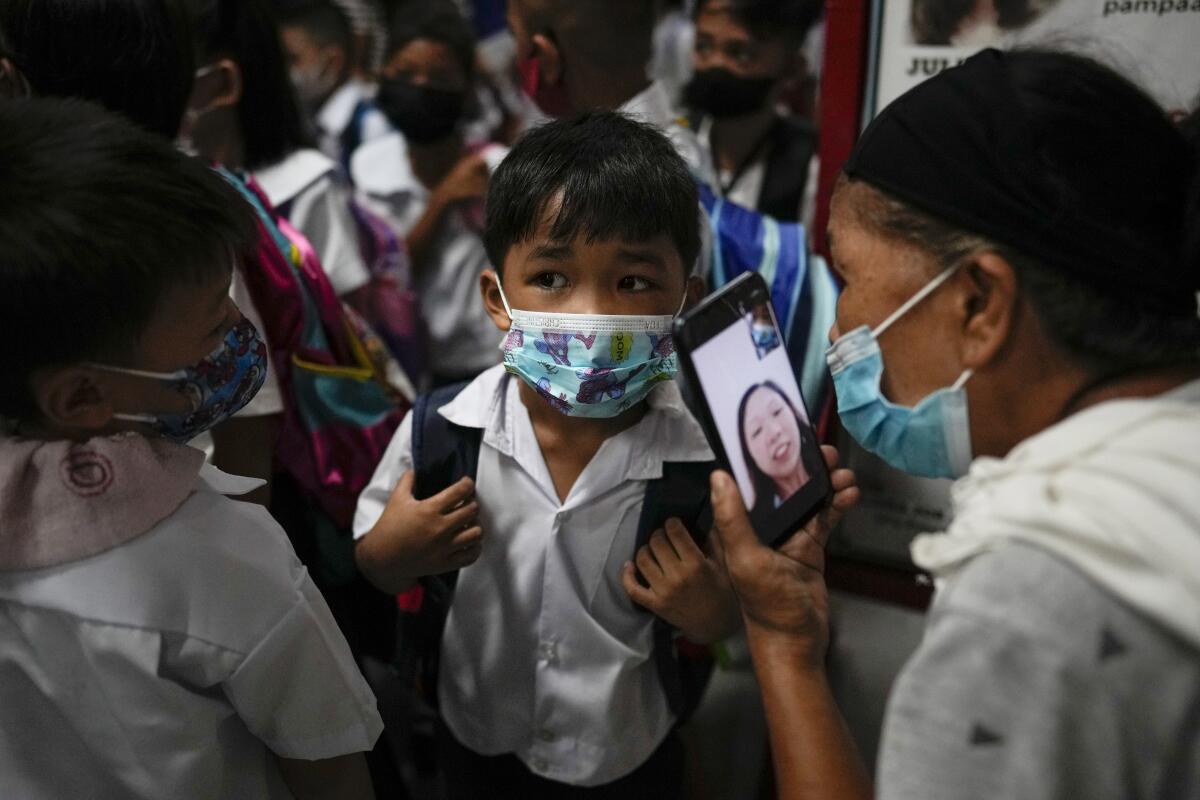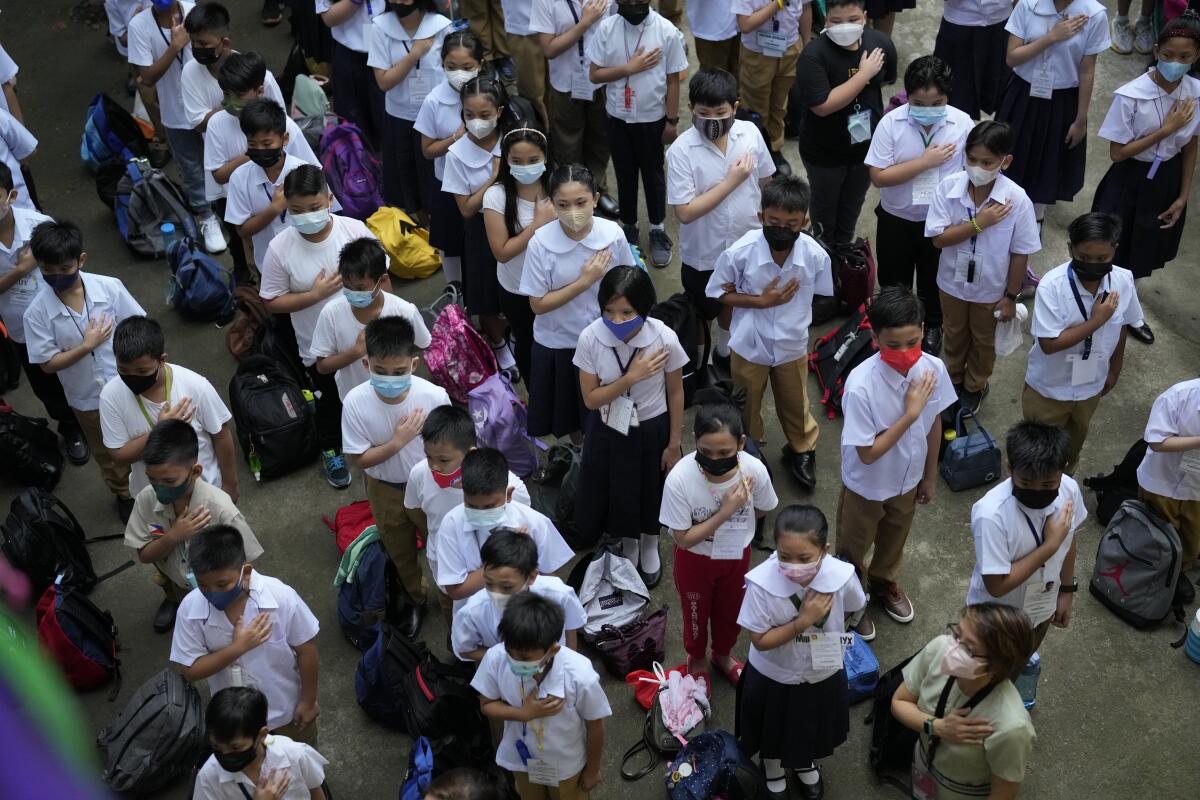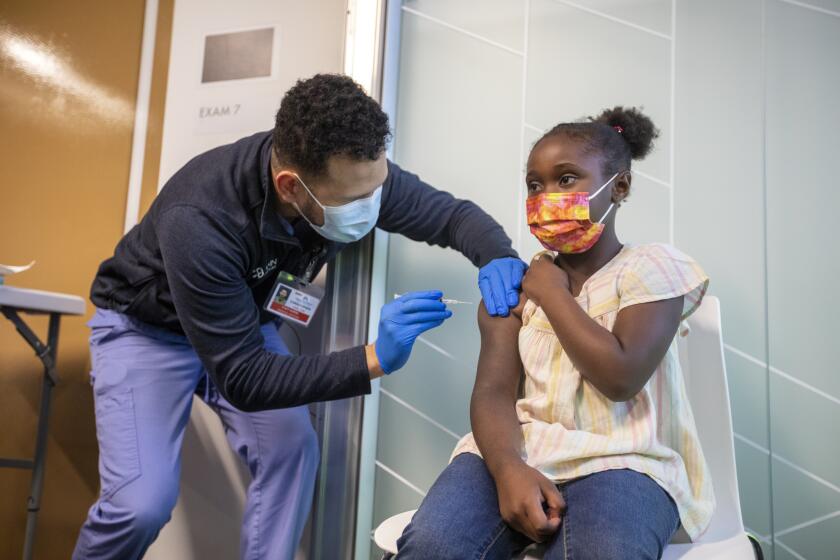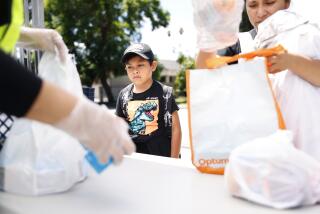Philippine kids back in school after 2 years lost to COVID-19

- Share via
MANILA — Millions of students in face masks streamed back to primary and secondary schools across the Philippines on Monday for their first in-person classes after two years of coronavirus lockdowns that are feared to have worsened alarming illiteracy rates among children.
Officials grappled with daunting problems — including classroom shortages, lingering COVID-19 fears, an approaching storm and quake-damaged school buildings in the country’s north — to welcome back nearly 28 million students who enrolled for the school year.
Teachers at one grade school in San Juan checked the temperatures of students and sprayed alcohol on their hands before letting them into classrooms.
Renaline Pemapelis, 27, excitedly gave last-minute instructions to her son, who was going to school for the first time. “I have mixed feelings, worried and excited,” she said.
Only about 24,000 of the nation’s public schools — roughly 46% — were able to begin in-person classes five times a week starting Monday. The rest will resort to a mix of in-person and online classes until Nov. 2, when all public and private schools are required to bring all students back to classrooms, education officials said.
But about 1,000 schools will be unable to shift entirely to face-to-face classes during the transition period for various reasons, including damage to school buildings wrought by a powerful earthquake last month in the north, officials said.
The CDC has updated its COVID-19 guidance in an effort to make things less confusing to Americans. Here’s what the agency recommends.
The Department of Education said some schools will have to split classes into up to three shifts a day due to classroom shortages, a longstanding problem, and to avoid overcrowding that could turn schools into new centers of coronavirus outbreaks.
“We always say that our goal is a maximum of two shifts only but there will be areas that would have to resort to three shifts because they’re really overcrowded,” Education Department spokesperson Michael Poa said.
Despite many concerns, education officials gave assurances that it’s “all-systems go” for Monday’s resumption of classes, he said.
Sen. Joel Villanueva, however, said such assurances have to be matched by real improvements on the ground.
“The era of missing classrooms, sharing tables and chairs and holding classes under the shade of trees must no longer happen,” said Villanueva, who filed two bills calling for additional grocery, transportation and medical allowances for public school teachers.
The Philippines was one of the Southeast Asian countries hit worst by the pandemic. Former President Rodrigo Duterte enforced one of the world’s longest coronavirus lockdowns and school closures. Before his six-year term ended June 30, Duterte continued to reject calls for a resumption of in-person classes due to fears it might ignite new outbreaks.

The prolonged school closures sparked fears that literacy rates among Filipino children — already at alarming levels before the pandemic — could worsen.
A World Bank study last year showed that about 9 out of 10 children in the Philippines were suffering from “learning poverty,” or the inability of children to read and understand a simple story by age 10.
“Prolonged school closures, poor health risk mitigation, and household-income shocks had the biggest impact on learning poverty, resulting in many children in the Philippines failing to read and understand a simple text by age 10,” UNICEF Philippines said in a statement.
“Vulnerable children such as children with disabilities, children living in geographically isolated and disadvantaged areas, and children living in disaster and conflict zones fare far worse,” the U.N. agency for children said.
Monday is Day 1 for L.A. Unified, the nation’s second-largest school system, as the school year begins across California.
Poa said 325 temporary learning spaces were being constructed in northern Abra province and outlying regions to replace school buildings battered by a July 27 quake.
Education officials also scrambled to help more than 28,000 students look for new schools after financial losses and other problems caused at least 425 private schools to close permanently since 2020. About 10,000 of the students have been enrolled in public schools, Poa said.
Poverty has also been a key hindrance to education. Crowds mobbed the Department of Social Welfare and Development offices Saturday to claim cash aid for indigent students, resulting in the injury of at least 26 people who were pinned in entrance gates.
Associated Press journalists Joeal Calupitan and Aaron Favila contributed to this report.
More to Read
Sign up for Essential California
The most important California stories and recommendations in your inbox every morning.
You may occasionally receive promotional content from the Los Angeles Times.












